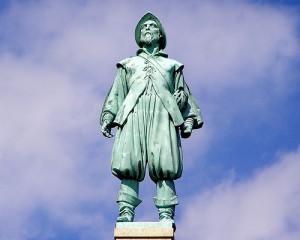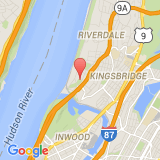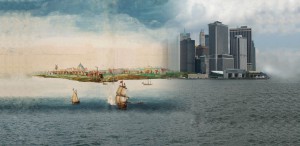Kevin Reshamwala, Nick Ramirez, Fatimah Ahmed, and Misha Faerovitch
Section 8



Physical Description:
The bronze statue of Henry Hudson stands at a height of 16 feet. The explorer is perched on top of a Milford pink granite column that is 100 feet while the monument itself is elevated at 200 feet. His stature gives the illusion that he is trying to balance himself on the ship’s deck. There is a cornerstone at the base of the monument that is made out of rock, stone, and metal. It depicts various scenes from the voyage to New York such as meeting with the Natives and making a deal with Dutch settlers.
Essay:
The Henry Hudson Statue is located on Spuyten Duyvil Hill in the Bronx borough of New York City (specifically Independence Avenue Bronx, NY 10463). In 1906, civic leaders wanted to create a statue as a homage to Hudson in commemoration of the 300th Anniversary of his arrival in New York Harbor. His ship, the Half Moon, was docked off the Spuyten Duyvil in preparation for a voyage to discover the Northwest Passage. Instead, he discovered the Hudson Bay.
Plans for the monument came into fruition in 1909 and construction was completed in 1937. In 1938, the statue was unveiled to the public. Architect Walter Cook created the column while sculptor Karl Bitter designed the statue. Unfortunately, Bitter passed away in 1915, prompting Bitter’s student Karl Heinrick Gruppe to finish the statue on his behalf.
In terms of Dutch history, the memorial represents the first voyage set forth by the Dutch. The captain, Henry Hudson, helped establish the first trading post on the Island of Manhattan. The memorial also commemorates Hudson’s charter with the Dutch East India Company, which was designed to find a path to Northern Asia.
We decided to analyze the statue of Henry Hudson because we believe the impact of his voyage is still felt today. If it wasn’t for Hudson, the Dutch culture and value system would not have spread across the region. New York City would not probably not have become the diverse metropolitan area that it is today without the Dutch beliefs about ethnic and religious tolerance. The statue of Henry Hudson reminds us of the Age of Exploration. It is a monument commemorating a frontiersmen who ventured outside the boundaries of his understanding and into the unknown.
Works Cited
Da Cruz, Frank. “Henry Hudson Memorial Column – Bronx NY – Living New Deal.” Living New Deal. Living New Deal, 02 Aug. 2015. Web. 06 Apr. 2016.
“English Title: View of New York by Johannes Vingboons.” The Atlantic World: America and the Netherlands. Global Gateway, 2016. Web. 06 Apr. 2016.
“Explorer-Age of Discovery.” Henry Hudson. The Mariners’ Museum, 2016. Web. 06 Apr. 2016.
“Henry Hudson Memorial Column, Bronx, New York City.” Flickr. Yahoo!, 2016. Web. 06 Apr. 2016.
“Henry Hudson Park-Henry Hudson Monument.” NYC Parks. New York City Department of Parks and Recreations. Web. 06 Apr. 2016.
“Monument Detail.” Fieldguide to U.S. Public Monuments and Memorials. Fieldguide to U.S. Public Monuments and Memorials, 2005. Web. 06 Apr. 2016.
